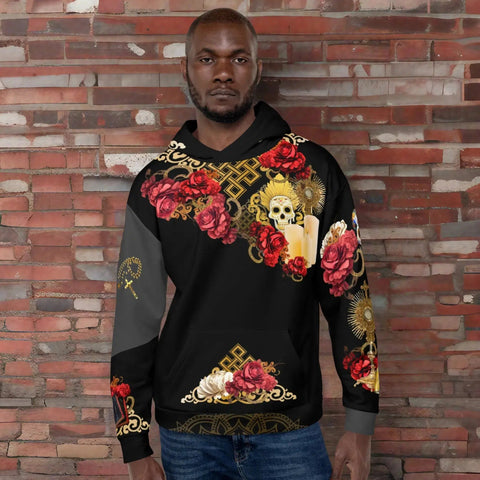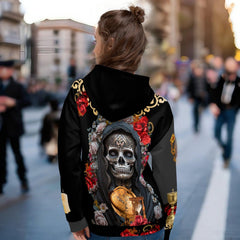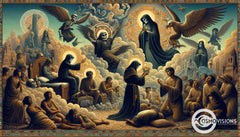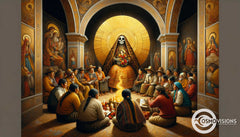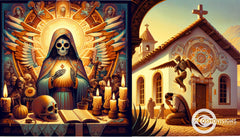Exploring the Symbolism and Iconography of Santa Muerte: A Comprehensive Analysis
Posted by Luciano Martucci
The mysterious figure of Santa Muerte stands cloaked in many colors, her gaze both solemn and intriguing. For those drawn to the rich tapestry of Mexican culture or fascinated by the intersection of spirituality and anthropology, she is a captivating presence begging for exploration.
People across the globe are often puzzled yet fascinated by this folk saint's widespread veneration, with her image evoking curiosity and wonder.
Santa Muerte is more than just an icon; she is a symbol deeply rooted in history that bridges ancient traditions with modern beliefs. Her story unfolds through vibrant rituals and devoted followers, offering glimpses into a spiritual practice that defies conventional religious boundaries.
This article will dive deep into Santa Muerte's symbolism and iconography, revealing insights into why she holds such profound significance for so many people.
Our journey together will unwrap layers of mystery surrounding this enigmatic saint—and perhaps even unravel some mysteries within ourselves. Ready to discover what secrets lie behind the veil? Keep reading as we delve into the world of La Santísima Muerte.
Historical Background of Santa Muerte
Santa Muerte has a rich historical background, stemming from ancient Mesoamerican beliefs and evolving through Mexican folk traditions. This section will explore the origins and evolution of Santa Muerte as a revered figure in Mexican culture.
Ancient History of Santisima Muerte
Traces of Santisima Muerte date back to the pre-Columbian era when indigenous tribes in what is now Mexico honored deities associated with death and the afterlife. One such deity was Mictlantecuhtli, an Aztec god who ruled over Mictlan, their underworld.
Despite Spanish colonization and the spread of Catholicism, these ancient beliefs merged with Christian practices, creating a form of religious syncretism that survived quietly for centuries.
By 1797, we find evidence of veneration for the personification of death in its folk saint form known as Santa Muerte or Holy Death. Hidden from mainstream society, followers conducted rituals and prayers in secret due to Catholic Church prohibitions against worshipping figures not recognized within their doctrine.
Devotion grew within marginalized communities who found solace and protection under her mantle—a continuation of age-old traditions honoring life's inevitable end through sacred rites.
![]()
Santa Muerte's Mexican Origins
Santa Muerte's presence in Mexico is a colorful tapestry of indigenous beliefs interwoven with Spanish colonial influence. Her image fuses together elements from Aztec deities of death and European personifications like the Grim Reaper, embodying a unique religious icon that resonates deeply with Mexican identity.
Followers often see her as a parallel to Catholic saints, yet distinct with her macabre symbolism and role as the saint of death.
Devotion to Santa Muerte has flourished within pockets of society where mainstream religion meets the fringes – among those who feel marginalized or engage in activities at odds with orthodox Christian doctrines.
In places like Tepito, known for its bustling market and reputation for contraband, she stands as an emblematic figure providing protection and solace. This underworld goddess transcends mere spiritual practice; she represents survival amid adversity.
Santa Muerte: A Folk Saint for the Marginalized
Santa Muerte holds a significant place as a folk saint, particularly for marginalized communities in Mexico and beyond. Despite controversy surrounding her worship, she plays an important role in the Day of the Dead celebrations and offers solace to those on the fringes of society.
The Controversy That Surrounds Santisima Muerte
The worship of Santa Muerte has sparked intense debate due to its association with the criminal underworld, particularly within Mexican cartels. Critics argue that her figure legitimizes narcoculture and lawlessness by providing spiritual protection to those involved in organized crime.
This portrayal by the media amplifies fears and prejudices surrounding her practices, casting a shadow over a complex tradition rooted in marginalized communities.
Meanwhile, devotees advocate for an understanding of Santa Muerte beyond these controversial associations. They perceive her as a powerful ally in their struggle against societal marginalization, offering solace to those facing discrimination or living on society's fringes.
Shifting our attention now to how she influences one of Mexico’s most significant traditions can provide broader insight into this multifaceted figure.
Role in the Day of the Dead
Santa Muerte plays a significant role in the Day of the Dead celebrations, especially among marginalized communities where she is venerated as a key figure. During this time, offerings and prayers are dedicated to Santa Muerte as she is believed to provide protection and guidance for those facing death or loss.
Her presence during these rituals symbolizes the acknowledgment of death as an integral part of life, offering comfort and solace to those who feel disenfranchised.
The inclusion of Santa Muerte in the Day of the Dead festivities reflects her appeal to individuals on the fringes of society and highlights her association with liminality and transition.
This acceptance also underscores her position as a powerful force that connects life with death, providing hope and empowerment for those who seek it.
![]()
Symbolism and Iconography of Santa Muerte
The symbolism and iconography of Santa Muerte can be found in the colors of her gown, the objects she holds, and the guardians at her feet. Each aspect represents different qualities and characteristics attributed to this folk saint, providing a deeper understanding of her significance in Mexican spirituality.
The Colors of Her Gown
Santa Muerte's gown is adorned in a variety of colors, each representing different intentions and desires. The color white embodies purity, cleansing, protection, and spiritual guidance.
Red signifies passion, love, and lust while black is associated with petitions to end negative situations and ward off enemies.
The various hues of Santa Muerte's gown hold significant meaning for her followers. Each colored tunic she wears symbolizes one of her seven powers. These colors carry deep symbolism in the practice of honoring Santa Muerte, representing specific desires and intentions that individuals seek from this revered figure.
The Objects She Holds
After exploring the symbolism behind the colors of Santa Muerte's gown, let's delve into the significance of the objects she holds. The scythe, a prominent symbol in her imagery, represents her power to cut the thread of life and control death.
This object embodies both fear and respect for death and serves as a reminder of mortality. Additionally, Santa Muerte is often depicted holding a globe, which signifies her dominion over the entire world and reflects her role as a powerful figure transcending boundaries.
The rose is another significant item held by Santa Muerte, symbolizing love, gratitude, and duality. It encapsulates the contrasting aspects of life and death that are inherent in her worship.
The Guardians at Her Feet
The guardians at the feet of Santa Muerte symbolize her protection and guidance. The scorpion represents defense against enemies, while the owl signifies wisdom and keen intuition.
Additionally, the scales of justice represent fairness in judgment. These objects reflect a deeper understanding of Santa Muerte’s role as a protector and guide for those who seek her help.
Understanding the symbolism of these guardians adds depth to one's connection with Santa Muerte and enhances appreciation for the multifaceted nature of her spiritual presence. It also serves as a reminder that she is not only an icon but also a powerful force in providing support and empowerment to those who venerate her.
Understanding the Role and Significance of Santa Muerte
Santa Muerte's scythe is a symbol of her power over life and death, representing the inevitable end for all mortals. Her depiction as a golden figure also signifies fortune and prosperity, making her an important figure in various rituals and prayers for success.
Her Scythe as a Symbol
Santa Muerte's scythe, a symbol of the power to cut down obstacles and clear the path to transformation. The scythe in her bony grip represents her ability to cut through life's challenges, guiding believers through both life and death.
This powerful imagery portrays Santa Muerte as a figure not just of death, but also of rebirth and renewal.
As an icon revered by many for protection and guidance, Santa Muerte's wielding of the scythe embodies strength and fearlessness. It reflects her role as a protector who can help individuals vanquish their troubles.
Power and Strength that Santa Muerte Carries
Representing her dominion over life and death, Santa Muerte carries a scythe that symbolizes her immense power. This imagery signifies her authority over all mortals, underlining her influence in the cycle of life.
By embracing the scythe, she embodies strength and control beyond human comprehension.
Embodying an unwavering force in Mexican culture, devotion to Santa Muerte reflects a deep reverence for her potent presence. Her association with power and strength is deeply ingrained in the beliefs of tactile practitioners who cherish tangible representations of faith.
The Golden Santa Muerte: A Symbol of Fortune
The golden Santa Muerte represents luck, wealth, and prosperity, making her a powerful symbol for those seeking financial success. Devotees of Santa Muerte believe that through prayers and offerings to the golden figure, they can attract money, business opportunities, and good fortune in gambling.
This depiction of Santa Muerte is also associated with healing and vitality, providing hope and blessings to those in need of physical or emotional wellbeing.
Santa Muerte's golden form embodies the desire for material abundance and success. Whether it's attracting wealth or seeking solace during difficult times, the golden Santa Muerte serves as a compelling representation of fortune and prosperity for believers.
![]()
Honoring Santa Muerte
Setting up an altar for Santisima Muerte and learning about prayers and love petitions for her. Explore the symbolism, significance, and practices of honoring Santa Muerte in your spiritual journey.
Read on to uncover the rich traditions associated with this revered folk saint.
Setting Up an Altar for Santisima Muerte
To set up an altar for Santisima Muerte, gather a table or shelf in a quiet, respectful space. Begin by covering the surface with a clean cloth in the colors associated with her – red, black, or white - to honor her. Arrange colored candles in red, black, and white to symbolize different aspects of her spiritual work. Place offerings such as tobacco, tequila, or coins on the altar to show respect and veneration. Add images or statues of Santa Muerte and decorate the space with flowers like marigolds or other favorites. Finally, light the candles and offer prayers or petitions to Santisima Muerte as a sign of devotion and admiration for her divine energy.
Prayers and Love Petitions for Santisima Muerte
Once the altar is set, devotees can offer prayers and love petitions to Santisima Muerte. Here are some common practices:
- Lighting colored candles that correspond to specific intentions, such as red for love and passion, white for purity and protection, and black for justice and protection from enemies.
- Using rosaries or prayer beads dedicated to Santisima Muerte while reciting prayers or petitions for assistance in matters of the heart, protection, or seeking justice.
- Offering symbolic items such as flowers, tobacco, coins, or small tokens representing desires or requests to Santa Muerte on her altar.
- Reciting specific prayers like the Novena prayer to seek blessings, guidance, love, and protection from Santisima Muerte.
- Making offerings of favorite foods and drinks as a way of showing devotion and appreciation for her intercession in their lives.
- Participating in group ceremonies that involve communal prayers or rituals dedicated to Santisima Muerte with like-minded practitioners.
- Engaging in acts of charity or goodwill as a form of devotion to Santisima Muerte, believing that it will bring favor and blessings from her spirit.













